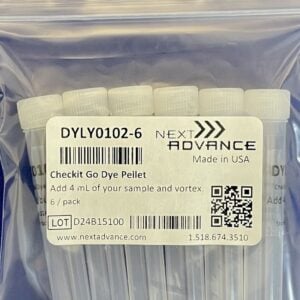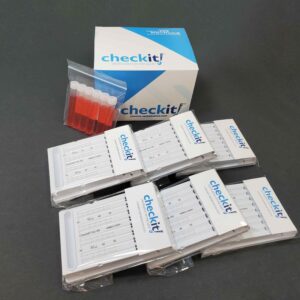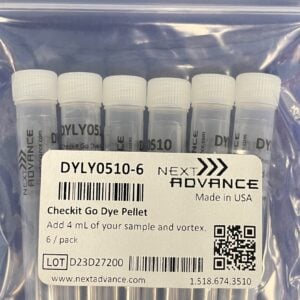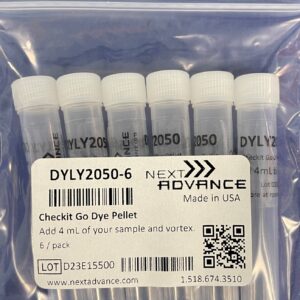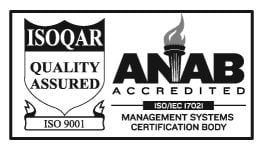2. Put cartridge(s) on the robot bed
3. Add dye to the reservoir
4. Run program
5. Flip well tab
6. Read the value with the cartridge on the robot deck (Do not pick it or lift it from the robot bed)
How do I program my robot to use the Checkit Go?
We have labware definitions at www.nextadvance.com/checkit-go/resources/ and an interface drawing available if you need to program your robot. Call us if you would like assistance.
How quickly should the tabs be lifted up?
To minimize evaporation losses, lift each tab immediately after dispensing dye into its well. Lift the tab at the same moderate rate you would use to turn on a light switch.
How hard do I need to push on the tab? How far?
A light touch is all that is needed to lift the tab, until you feel it stop moving. Leaving the tab up will reduce evaporation, thereby providing you more time to compare the meniscus to the adjacent markings.
Can I use my robot to lift the tab up on the Checkit Go?
Yes. You can use your robot to lift up the tab if it comes equipped with a paddle to perform this task. You may also be able to program precise motions to perform this action with the pipette tips themselves, as shown at right with an Integra Assist Plus.
You should read the volume within half a minute. Leave it in place so that the dye does not move inside the capillaries.
How accurate is the Checkit Go?
The Checkit Go is accurate to within 2%, typically within 1%.
Can the Checkits be used to test someone’s pipetting technique?
Yes, one good application of the Checkits is testing the accuracy of a person’s pipetting technique.
Can the Checkits be re-used?
No, the Checkits are designed to be disposable.
Can I replace the glass capillaries?
No. To ensure accurate readings, the capillaries are very precisely positioned in our manufacturing facility to within .001 to .002 inches (25 to 50 micrometers).
Is the Checkit’s performance affected by changes in temperature?
Temperature does not have a significant effect on the Checkits. The evaporation effects are minimal once the droplet is in the glass capillaries. Thus making it more accurate than a scale. While the density of the water changes (and so the observed mass for a given volume) between 4-40°C, the glass capillaries are not subject to much thermal expansion over this range. Therefore, the volume should stay very close to accurate between these temperatures. Since the Checkit measures volume, there is no conversion of units as with a spectrophotometer or a scale. Given the Checkit works with most sample liquids, it is a more accurate reflection of how your robot performs.
How level does the work surface have to be?
The Checkits should be fine on the deck of your robot. The glass capillaries are mounted at a slight incline to ensure that capillary action draws all the dye into the capillary, slightly uphill, against gravity.
How do I dispose of the dye?
The dye is safe and non-toxic. It can be disposed down a sink drain.
Is Checkit Go compatible with solutions containing 2% SDS or other surfactants?
Surfactants can interfere with the operation of Checkit. Find a list of solutions that are compatible on the Features page.
Do Checkit Go kits include the dye pellets? I want to verify the volume dispense from my liquid handler with the solutions that it typically dispenses and as such, I will need the dye pellets
The Checkits are shipped with aliquots of dye. Pellets (pack of 6) can be purchased separately. Please note that pellets are purchased based on the Checkit Go model: DYLY2050 – for 20 and 50 µL models, DYLY0510 – for 5 and 10 µL models; and DYLY0102 – for 1 and 2 µL models.
Which liquid classes are or are not compatible with Checkit Go devices?
Aqueous solutions, which covers most liquids used in biology, will work. One example that does not work is straight DMSO. But when DMSO is in a solution with water it will work. Avoid solutions with surfactants or proteins, which reduce the capillary action that the Checkits rely upon. Many of the liquids we use in assays are diluted in water making them compatible with the Checkit. Refer to this table for some common liquids that are compatible. We are always working to test more liquids. If your liquid of interest is not listed here, contact us: [email protected].
“Unlike gravimetric or colorimetric methods, the Checkit Go works with most sample liquids”. Can you clarify which sample liquids are compatible with Checkit Go that are not compatible with gravimetric or colorimetric methods?
Typically only very pure liquids such as distilled water work with a gravimetric method because the liquid’s density must be very accurately known. Colorimetric tests are also limited to specific solutions. The Checkit system directly measures volume so it provides very accurate measurements for a wide range of liquids. You don’t need to know any of the liquid’s properties, such as density or optical absorbance at a specific wavelength.

